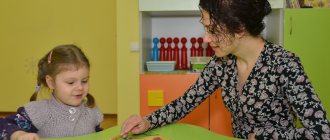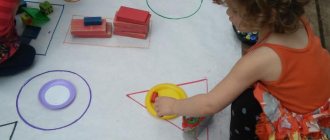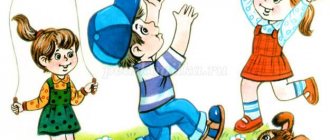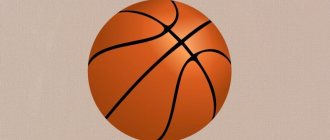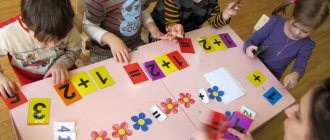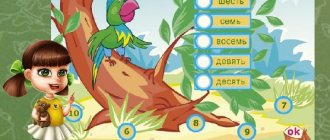3.2. Methods and techniques for forming elementary mathematical representations
3.2.
Methods and techniques for forming elementary mathematical representations
Method
(Greek
metodos
- literally “path to something”), a way to achieve a goal.
Teaching methods
– methods of interrelated activities of teachers and students aimed at achieving the goals of education, upbringing and development of schoolchildren (Babansky Yu.K.).
Currently, there are several different classifications of didactic methods in pedagogy.
One of the first was classification, which was dominated by verbal methods. Ya. A. Komensky, along with verbal ones, began to spread another method based on acquiring information not from words, but “from the ground, from oaks and beeches,” that is, through knowledge of the objects themselves.
At the beginning of the 20th century. the classification of methods was mainly carried out according to the source of knowledge - these were verbal, visual, practical methods.
During the formation of preschool education, the development of methods for the formation of elementary mathematical concepts was influenced by methods of teaching mathematics in elementary school. The monographic method of A.V. Grube and the computational method (method of studying actions) penetrated into the practice of kindergartens. E.I. Tikheeva and F.N. Bleher introduced the game as a teaching method. Since the 50s. Practical methods are increasingly used in teaching children (A. M. Leushina).
At the present stage, various teaching methods
:
- practical,
- visual,
- verbal,
- gaming
When choosing methods, a number of factors are taken into account:
- goals, objectives;
- content of FEMP at this stage;
- age and individual characteristics of children;
- the teacher’s personal attitude to certain methods;
- specific conditions in which the educational process takes place;
- availability of necessary teaching aids, etc.
The most rational is a combination of various methods.
The leading method is considered to be the practical one. Its essence lies in organizing the practical activities of children, aimed at mastering special ways of acting with objects, on the basis of which elementary mathematical concepts arise.
Characteristic features of the practical method for FEMP:
- performing a variety of practical actions that serve as the basis for mental activity;
- widespread use of didactic material;
- the emergence of ideas as a result of practical actions with didactic material;
- widespread use of formed elementary mathematical concepts in everyday life, play, and work.
This method proposes the organization of special exercises, which can be offered in the form of a task, organized as actions with demonstration material, or proceed in the form of independent work with handouts.
Types of exercises
:
- by number of participants
- collective;
- group;
- individual.
- from the point of view of children’s manifestation of activity, independence, creativity
- reproductive
(the actions of children are completely regulated by adults in the form of an image, an explanation, a requirement, a rule that determines what and how to do)
- productive
(characterized by the fact that children must fully or partially discover the method of action themselves)
Game methods
used in all age groups: in younger ones - in the form of a surprise moment, imitation movements, a fairy-tale character, etc.; in older children they take on the character of search and competition.
Didactic games are the most widely used. Thanks to the developmental task, clothed in a game form (game meaning), game actions and rules, the child unintentionally learns certain cognitive content. All types of didactic games (subject, board-printed, verbal) are an effective means and method of FEMT for children. The game can be classified as a group of practical methods.
Visual and verbal methods
when forming elementary mathematical concepts, they are not basic, but accompany practical and game methods.
Visual methods: demonstration of objects and illustrations, observation, display, examination of tables, models.
Verbal methods: storytelling, conversation, explanation, explanations, verbal didactic games.
Often in one lesson different methods are used in different combinations.
Methodical technique
- an integral part of the method. As is known, mutual transitions are possible between methods and methodological techniques.
To form elementary mathematical concepts in children, techniques related to visual, verbal and practical methods and used in close unity with each other are used:
- Show
(demonstration) of a method of action combined with an explanation, or
example of a teacher
.
The main method of training, familiarization with new actions, is visual and effective. It is carried out using a variety of didactic means and makes it possible to form ideas and skills in children.
The following requirements apply to it:
- clarity, dissection of the demonstration of the method of action;
- consistency of action with verbal explanations;
- accuracy, brevity and expressiveness of speech accompanying the demonstration;
- activation of perception, thinking and speech of children.
- Instructions for performing independent exercises.
This technique is associated with the teacher’s demonstration of methods of action and follows from it. The instructions reflect what and how to do to get the desired result. In older groups, instructions are given in full before the task begins; in younger groups, it precedes each new action.
- Explanations, clarifications, instructions.
These verbal techniques are used by the teacher when demonstrating a method of action or while children are performing a task in order to prevent mistakes, overcome difficulties, etc. They should be specific, short and figurative.
- Questions for children
– one of the main techniques of FEMP in all age groups.
Types of questions:
- reproductive-mnemonic: (How many? What is it? What is the name of this figure? How are square and triangle similar?);
- reproductive-cognitive: (How many cubes will be on the shelf if I put one more? Which number is greater (smaller): nine or seven?);
- productive-cognitive: (What needs to be done to make the circles 9? How to divide the strip into equal parts? How can you determine which flag in the row is red?).
Questions activate children’s perception, memory, thinking, and speech, ensuring comprehension and mastery of the material.
Basic requirements for questions as a methodological technique:
- accuracy, specificity, laconicism;
- logical sequence;
- variety of wording, i.e. the same thing should be asked differently;
- the optimal balance between reproductive and productive issues depending on age and the material being studied;
- questions should prompt the child to think, highlight what is required, carry out analysis, comparison, juxtaposition, generalization;
- the number of questions should be small, but sufficient to achieve the set didactic goal;
- Prompt and alternative questions should be avoided;
- We ask the question to the whole group, and the called child answers it. In some cases, choral responses are also possible, especially in younger groups. Children need to be given the opportunity to think about their answer.
Older preschoolers should be taught to formulate questions independently. In a specific situation, using didactic material, the teacher invites children to ask about the number of objects, their ordinal place, size, shape, method of measurement, etc.
The answers should be:
- short or complete, depending on the nature of the question;
- independent conscious;
- accurate, clear, loud enough;
- grammatically literate (observance of word order, rules of their agreement, use of special terminology).
- Control and evaluation.
These techniques are interrelated. Control is carried out through monitoring the process of children completing tasks, the results of their actions, and answers. These techniques are combined with instructions, explanations, clarifications, demonstration of the method of action to adults as a model, direct assistance, and include correction of errors.
Assessment is given to the methods and results of actions and children’s behavior. In the older group, the adult's assessment is combined with the assessment of friends and self-esteem. The assessment is different in different age groups.
- Comparison, analysis,
synthesis
,
generalization
act not only as cognitive processes (operations), but also as methodological techniques that determine the path along which the child’s thought moves in the learning process. Based on analysis and synthesis, children are led to a generalization, which usually summarizes the results of all observations and actions. Comparison, analysis, synthesis, generalization are carried out on a visual basis using a variety of didactic means. Observations, practical actions with objects, reflection of their results in speech, questions to children are the external expression of these methodological techniques, which are closely interconnected, connected and used comprehensively. - Modeling
– a visual and practical technique, including the creation of models and their use for the purpose of developing elementary mathematical concepts in children. Models are widely used in the formation of temporal representations (model of parts of the day, week, year, calendar) and quantitative (numerical ladder, numerical figure, etc.), spatial (models of geometric figures), etc.
The use of models and modeling puts the child in an active position and stimulates his cognition.
- Problem situations
occur when:
- the connection between the fact and the result is not revealed immediately, but gradually. This raises the question: what is it? (we lower different objects into the water: some drown, others don’t);
- after presenting some part of the material, the child needs to make an assumption (experiment with warm water, melting ice, problem solving);
- To understand a fact, it is necessary to compare it with other facts, create a system of reasoning, that is, perform some mental operations (measurement with different measures, counting in groups, etc.).
The structure of a problem situation includes problematic questions that contribute to understanding the essence of the action being performed and the development of intelligence.
The problem situation is resolved in stages:
1) awareness and acceptance of the problem;
2) children making assumptions;
3) practical testing of assumptions;
4) justification of a rational way to solve a problematic problem.
Example of a problem situation
A bear, a hedgehog, and a mouse came to visit. We need to feed them, but mom went to the store. How do we feed them? What utensils should I take?
1) Counting (count guests and the same number of plates, cups). 2) Size (a big bear gives him a big plate, a smaller hedgehog, and a small mouse).
3) Also choose furniture.
Literature
- Formation of elementary mathematical concepts in preschoolers / ed. A.A.Stolyar. – M., Education 1988 (p. 114-124)
- Shcherbakova E.I. Methods of teaching mathematics in kindergarten: a textbook for preschool students. department and faculty avg. ped. textbook establishments. - M., Ed. , 1998 (p.86-92)
4
Introducing mathematics in a playful way
For a child, everything in the world is a game. And the game is both study and work, and a way of understanding reality. It needs to be included in the educational process. That is, to lead, direct, organize. Thus, it is possible to influence different aspects of the personality: in total, sensations, consciousness, will and behavior.
Children enjoy play activities as a process. Teachers and parents have a different goal. They need to develop a preschooler, put certain knowledge into his head, and develop personal qualities. Didactic games and exercises are especially useful. They provoke relaxed interaction between participants and teach them how to communicate.
Board games are very helpful in forming ideas about forms, sequences, contradictions and other things. They save you right away. You can make cards for such games yourself. But there are ready-made game sets, they are bright and cost a penny. This is for example:
- lotto “Logical tables” for 3-6 years;
- games like “What’s extra?” (there are many options, for example this one from 3 years old and this one for 4-7 years old );
- funny toy “Whose cat is bigger?” to compare numbers;
- "Find a similar figure";
- "Katamino" (mini road version) develops spatial thinking.
Mathematical riddles will help you master terminology
Another good thing is math-themed riddles. They teach kids independence and perseverance. After all, you often need to not just say the answer, but prove it. The beauty of riddles is that they teach you to use mental operations (synthesize, analyze, compare, generalize). Here are examples of riddles:
I am a dash in grammar, and who am I in mathematics? (Minus)
I have no corners, And I look like a dish, Like a plate and a lid, Like a ring and a wheel. (Circle)
The cunning brothers live in a difficult book. There are ten of them, but these brothers will count everything in the world. (Numbers)
There are also humorous puzzles that teach you to look for answers outside the box. For example: “You and I, and you and me, how many of us are there in total?” (2). “How many ends does the stick have, two, two and a half?” (in the latter case – 6).
